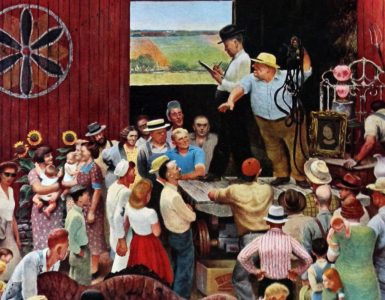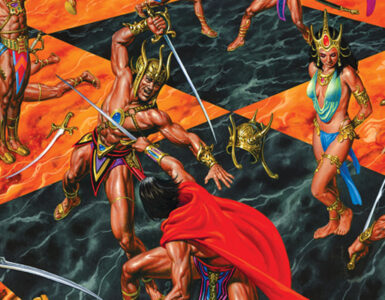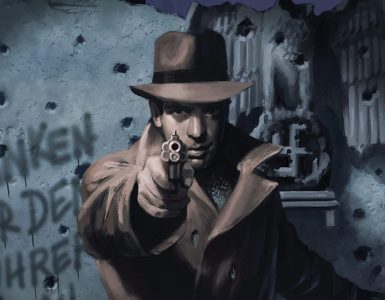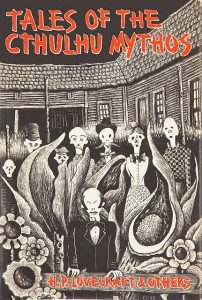 During the late summer of 1926, H. P. Lovecraft wrote “The Call of Cthulhu.” Initially rejected by WEIRD TALES editor Farnsworth Wright, it was first published in “The Unique Magazine” in its February 1928 issue. Although three related stories predated it — “The Nameless City,” “The Hound,” and “The Festival” — in what has come to be known as “The Cthulhu Mythos,” “The Call of Cthulhu” is a seminal work of its author. As writer and Lovecraft correspondent Fritz Leiber observed, “Here for the first time, Lovecraft moves horror from the realm of Earth to the stars.”
During the late summer of 1926, H. P. Lovecraft wrote “The Call of Cthulhu.” Initially rejected by WEIRD TALES editor Farnsworth Wright, it was first published in “The Unique Magazine” in its February 1928 issue. Although three related stories predated it — “The Nameless City,” “The Hound,” and “The Festival” — in what has come to be known as “The Cthulhu Mythos,” “The Call of Cthulhu” is a seminal work of its author. As writer and Lovecraft correspondent Fritz Leiber observed, “Here for the first time, Lovecraft moves horror from the realm of Earth to the stars.”
In the years remaining to Lovecraft following the publication of “The Call of Cthulhu,” he expanded on its themes in such tales as “The Whisperer in Darkness,” “At the Mountains of Madness,” and “The Shadow Out of Time,” depicting a universe of mind-numbing horror that was a reflection of his own materialistic atheism. During this period, Lovecraft invited other writers to pen their own tales using the “synthetic folklore” he had created. “I think it is rather good fun to have this artificial mythology given an air of verisimilitude by wide citation.” Some of the authors who responded with their own “Cthulhu” fiction were Clark Ashton Smith, Robert E. Howard, Robert Bloch, Frank Belknap Long, Henry Kuttner, and August Derleth.
“All of our gang frequently allude to the pet daemons of the others — thus Smith uses my Yog-Sothoth, while I use his Tsathoggua. Also, I sometimes insert a devil or two of my own in the tales I revise or ghost-write for professional clients. Thus our black pantheon acquires an extensive publicity & pseudo-authoritativeness it would not otherwise get.”
In later years, particularly following the death of “the old gentleman,” August Derleth worked to expand Lovecraft’s so-called “mythos,” albeit shaping it in a way that some scholars claim to be a corruption of the original author’s intent. Derleth’s “Cthulhu Mythos,” as the story-type came to be known, shifted away from Lovecraft’s nihilistic universe toward a more “good versus evil” backdrop. Other writers, notably Lin Carter and Brian Lumley, continued this process, basing their work on what Lovecraftian scholars have labeled, “the black magic quote,” purportedly written by Lovecraft:
“All my stories, unconnected as they may be, are based on one fundamental lor or legend: that this world was inhabited an one time by another race, who in practicing black magic, lost their foothold and were expelled, yet live on outside, ever ready to take possession of this earth again.”
Although Derleth may have corrupted Lovecraft’s “synthetic folklore,” twisting it away from its author’s intent, he also helped to popularize Lovecraft’s fiction through his Arkham House Publishers, significantly expanding Lovecraft’s reputation. The New Englander’s visions increasingly came under the microscope of academia and amateur scholars. His fiction became more widely read and popular, leading to adaptations in a variety of media including motion pictures, television, comic books, role-playing and video games, and even action figures and other toys. His stories are known the world over and though he lived much of his life in poverty, Lovecraft’s words and ideas have been transformed into a multi-million-dollar industry.
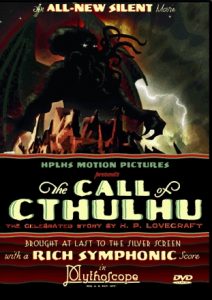 As part of its celebration of the 125th anniversary of the birth of H. P. Lovecraft, PulpFest 2015 is proud to welcome John D. Haefele, author of A LOOK BEHIND THE DERLETH MYTHOS, a critically acclaimed account of the birth of the Cthulhu Mythos; Don Herron, editor of the scholarly landmark, THE DARK BARBARIAN, and winner of the 2006 Black Circle Award for lifetime achievement in Robert E. Howard studies; popular culture scholar Rick Lai, who regularly appears as a panelist on podcasts produced by THE LOVECRAFT eZINE; Professor Tom Krabacher of California State University, Sacramento and a member of the Pulp Era Amateur Press Association; and Nathan Vernon Madison, a researcher involved in The Pulp Magazines Project and author of the Eisner-nominated ANTI-FOREIGN IMAGERY IN AMERICAN PULPS AND COMICS for a presentation entitled “The Call of Cthulhu: The Development of Lovecraft’s Mythos.” Scheduled for Friday evening, August 14th, at 9:50 PM, our panelists are promising a lively discussion that will explore the inspirations and origins of the Cthulhu Mythos as opposed to the Lovecraft’s Mythos and the Mythos of his contemporaries, as well as the controversies and personalities involved with these ideas over the years.
As part of its celebration of the 125th anniversary of the birth of H. P. Lovecraft, PulpFest 2015 is proud to welcome John D. Haefele, author of A LOOK BEHIND THE DERLETH MYTHOS, a critically acclaimed account of the birth of the Cthulhu Mythos; Don Herron, editor of the scholarly landmark, THE DARK BARBARIAN, and winner of the 2006 Black Circle Award for lifetime achievement in Robert E. Howard studies; popular culture scholar Rick Lai, who regularly appears as a panelist on podcasts produced by THE LOVECRAFT eZINE; Professor Tom Krabacher of California State University, Sacramento and a member of the Pulp Era Amateur Press Association; and Nathan Vernon Madison, a researcher involved in The Pulp Magazines Project and author of the Eisner-nominated ANTI-FOREIGN IMAGERY IN AMERICAN PULPS AND COMICS for a presentation entitled “The Call of Cthulhu: The Development of Lovecraft’s Mythos.” Scheduled for Friday evening, August 14th, at 9:50 PM, our panelists are promising a lively discussion that will explore the inspirations and origins of the Cthulhu Mythos as opposed to the Lovecraft’s Mythos and the Mythos of his contemporaries, as well as the controversies and personalities involved with these ideas over the years.
Join PulpFest 2015 at the beautiful Hyatt Regency in downtown Columbus, Ohio, beginning on Thursday, August 13th and running through Sunday, August 16th, for a salute to H. P. Lovecraft and WEIRD TALES, just a few short days before the author’s 125th birthday. Although our host hotel is completely booked, there are still some rooms available at nearby hotels. Please click here and you’ll find a link to a list of hotels to choose from. If you are not from the Columbus area and want to attend PulpFest 2015, we urge you to book your room now and not later. Rooms that are relatively close to PulpFest are disappearing fast during the time frame of our convention.
(The first edition of TALES OF THE CTHULHU MYTHOS is credited to “H. P. Lovecraft and Others.” Edited and with an Introduction by August Derleth, it was released in 1969 by Arkham House Publishers in an edition of 4024 copies. The jacket art was created by the incomparable Lee Brown Coye who twice won the “World Fantasy Award for Best Artist.” Coye and his artwork will be the subject of a presentation at PulpFest 2015 on Saturday afternoon, August 15th, beginning at 2:30 PM.
As Lovecraft’s fiction became more widely read and popular, it led to adaptations in a variety of media including motion pictures, television, comic books, role-playing and video games, and even action figures and other toys. It was left to an organization devoted to the live-action role-playing game CTHULHU LIVES, to create one of the most faithful film adaptations of the work of H. P. Lovecraft. In 2005, the H. P. Lovecraft Historical Society released THE CALL OF CTHULHU, a silent movie based on Lovecraft’s 1928 story. PulpFest will be offering a fully authorized showing of this film on Friday, August 14th, beginning at 11:30 PM. It will be accompanied by “Cool Air,” an episode from ROD SERLING’S NIGHT GALLERY that originally aired in 1971. Learn more by reading “The Films of H. P. Lovecraft.”
Please be sure to visit pulpcon.org/pulpfest-2015-registration-information/ to learn how to register for “Summer’s Great Pulp Con” and be part of our salute to H. P. Lovecraft, WEIRD TALES, and the art of Lee Brown Coye.)

